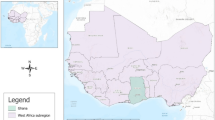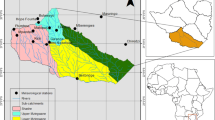Abstract
In this paper, we investigate the spatial and temporal distributions of rainfall in Qatar, which falls in the arid region of the middle-east. We use rainfall data from 29 rain gauges covering the period of 1962–2010. Fifteen different rainfall indices are used in the assessment. A combination of Mann–Kendall and Spearman’s Rho tests is adopted to identify trends in the rainfall data. The average annual rainfall values are found to be in the range of 55.5–99 mm. A sharp gradient in average annual rainfall is noticed, with north having much higher values than the south. A mixed trend, both increasing (upward) and decreasing (downward) for most of the rainfall indices, is identified. Annual total and maximum daily rainfalls show mixed trends, while rainy days show an increasing trend. For the rainy seasons, the total rainfall during the months of December–January–February shows an increasing trend and March–April rainfall shows a decreasing trend, reflecting that seasonal rainfall in Qatar is changing. The findings of this study provide important insights into the nature of rainfall variability in Qatar, which will be useful in water resources planning tasks in Qatar and nearby countries.











Similar content being viewed by others
References
Adamowski K, Bougadis J (2003) Detection of trends in annual extreme rainfall. Hydrol Process 17:3547–3560
Alexander LV, Zhang X, Peterson TC, Caesar J, Gleason B, Klein Tank AMG et al (2006) Global observed changes in daily climate extremes of temperature and precipitation. J Geophys Res Atmos 111:D05109. doi:10.1029/2005JD006290
Alexander LV, Hope P, Collins D, Trewin B, Lynch A, Nicholls N (2007) Trends in Australia’s climate means and extremes: a global context. Aust Meteorol Mag 56:1–18
Almazroui M, Islam MN, Jones PD, Athar H, Rahman MA (2012a) Recent climate change in the Arabian Peninsula: seasonal rainfall and temperature climatology of Saudi Arabia for 1979–2009. Atmos Res 111:29–45
Almazroui M, Islam MN, Athar H, Jones PD, Rahman MA (2012b) Recent climate change in the Arabian Peninsula: annual rainfall and temperature analysis of Saudi Arabia for 1978–2009. Int J Climatol 32:953–966
AlSarmi S, Washington R (2011) Recent observed climate change over the Arabian Peninsula. J Geophys Res 116:D11109
AlSarmi SH, Washington R (2013) Changes in climate extremes in the Arabian Peninsula: analysis of daily data. Int J Climatol. doi:10.1002/joc.3772
Arnbjerg-Nielsen K, Willems JO, Beecham S, Pathirana A, Gregsrsen IB, Madsen H, Nguyen VTV (2013) Impacts of climate change on rainfall extremes and urban drainage systems: a review. Water Sci Technol 68(1):16–28
Batanouny KH (1981) Ecology and flora of Qatar. University of Qatar, Doha
Bazaraa AS, Ahmed S (1991) Rainfall characterization in an arid area. Engineering Journal of Qatar University, Doha
Chowdhury RK, Beecham S (2010) Australian rainfall trends and their relation to the southern oscillation index. Hydrol Process 24(4):504–514
Christensen, JH et al. (2013). Climate phenomena and their relevance for future regional climate change. In: Stocker TF et al. (eds.) Climate change 2013: the physical science basis. Contribution of working group I to the fifth assessment report of the intergovernmental panel on climate change. Cambridge University Press, Cambridge
Clarke C, Hulley M, Marsalek J, Watt E (2011) Stationarity of AMAX series of short-duration rainfall for long-term Canadian stations: detection of jumps and trends. Can J Civ Eng 38:1175–1184
CRC for Catchment Hydrology (2005) Trend user guide. CRC for Catchment Hydrology, Australia
Elagib NA, Addin Abdu AS (1997) Climate variability and aridity in Bahrain. J Arid Environ 36:405–419
Evans JP, Ronald BS, Robert JO (2004) Middle East simulation and dominant precipitation processes. Int J Climatol 24:1671–1694
Feulner GR (2006) Rainfall and climate records from Sharjah Airport: historical data for the study of recent climatic periodicity in the U.A.E. Tribulus J Emir Nat Hist Group 16(1):3–9
Freiwana M, Kadioglu M (2008) Climate variability in Jordan. Int J Climatol 28:69–89
Garcia de Pedraza L, Garcia-Vega C (1989) La sequia y el clima de Espana. CalendarioMeteorologico. Instituto Nacional de Meteorologia, Madrid
Ghazanfar SA, Fisher M (eds) (1998) Vegetation of the Arabian Peninsula. Kluwer, Dordrecht
Gong D, Shi P, Wang J (2004) Daily precipitation changes in the semi arid region over northern China. J Arid Environ 59:771–784
Haddad K, Rahman A, Green J (2011) Design rainfall estimation in Australia: a case study using L moments and generalized least squares regression. Stoch Env Res Risk Assess 25(6):815–825
Hasanean HM (2004) Middle east meteorology. UNESCO-EOLSS Joint Committee Secretariat, Paris
Hosking JRM, Wallis JR (1997) Regional frequency analysis: an approach based on L-moments. Cambridge University Press, Cambridge
IPCC (2014) Climate change 2014: synthesis report. In: Core Writing Team, Pachauri RK, Meyer LA (eds) Contribution of working groups I, II and III to the fifth assessment report of the intergovernmental panel on climate change. IPCC, Geneva
Ishak E, Rahman A, Westra S, Sharma A, Kuczera G (2013) Evaluating the non-stationarity of Australian annual maximum flood. J Hydrol 494:134–145
Kendall MG (1975) Rank correlation methods. Griffin, London
Khaliq MN, Ouarda TBMJ, Ondo JC, Gachon P, Bobée B (2006) Frequency analysis of a sequence of dependent and/or non-stationary hydro-meteorological observations: a review. J Hydrol 329(3–4):534–552
Kumar N, Yadav BP, Tyagi A, Jaswal AK (2012) Trend and spatial distribution of rainfall & rainy days over Andaman & Nicobar Islands. Nat Hazards 63:575–587
Kwarteng AY, Dorvlob AS, Vijaya Kumar GT (2009) Analysis of a 27-year rainfall data (1977–2003) in the Sultanate of Oman. Int J Climatol 29:605–617
Laz OU, Rahman A, Yilmaz A, Haddad K (2014) Trends in sub hourly, sub daily and daily extreme rainfall events in eastern Australia. J Water Clim Change 5(4):667–675. doi:10.2166/wcc.2014.035
Lazaro R, Rodrigo FS, Gutierrez L, Domingo F, Puigdefabregas J (2001) Analysis of a 30-year rainfall record (1967–1997) in semi-arid SE Spain for implications on vegetation. J Arid Environ 48:373–395
Leahy P, Kiely G, Scanlon TM (2004) Managed grasslands: a greenhouse gas sink or source? Geophys Res Lett. doi:10.1029/2004GL021161
Mamoon AA, Jeorgensen NE, Rahman A, Qasem H (2016) Design rainfall in Qatar: sensitivity to climate change scenarios. Nat Hazards J. doi:10.1007/s11069-016-2156-9
Mann HB (1945) Non-parametric tests against trend. Econometrica 13:245–259
Membery D (1997) Unusually wet weather across Arabia. Weather 52(6):166–174. doi:10.1002/j.1477-8696.1997.tb06303.x
Milly PCD, Betancourt J, Falkenmark M, Hirsh RM, Zbigniew W, Kundzewicz ZW, Lettenmaier DP, Stouffer RJ (2008) Stationarity is dead: whither water management? Science 319:573–574
Modarresa R, Silva VDPRD (2007) Rainfall trends in arid and semi-arid regions of Iran. J Arid Environ 70:344–355
Nasrallah HA, Balling RC Jr (1993) Analysis of recent climatic changes in the Arabian Gulf region. Environ Conserv 20(3):223–226. doi:10.1017/S0376892900023006
Nasrallah HA, Balling RC Jr (1996) Analysis of recent climatic changes in the Arabian Peninsula region. Theor Appl Climatol 53(4):245–252. doi:10.1007/BF00871740
Noy-Meir I (1973) Desert ecosystems: environment and producers. Annu Rev Ecol Syst 4:25–51
Partal T, Kahya E (2006) Trend analysis in Turkish precipitation data. Hydrol Process 20:2011–2026
Rehman S (2010) Temperature and rainfall variation over Dhahran, Saudi Arabia, (1970–2006). Int J Climatol 30:445–449
Sherif M, Almulla M, Shetty A, Chowdhury RK (2013) Analysis of rainfall, PMP and drought in the United Arab Emirates. Int J Climatol. doi:10.1002/joc.3768
Westra S, Sisson SA (2011) Detection of non-stationarity in precipitation extremes using a max-stable process model. J Hydrol. doi:10.1016/j.jhydrol.2011.06.014
Xu ZX, Li JY, Liu CM (2007) Long-term trend analysis for major climate variables in the Yellow River basin. Hydrol Process 21:1935–1948
Yue S, Pilon P, Cavadias G (2002) Power of the Mann–Kendall and Spearman’s rho tests for detecting monotonic trends in hydrological series. J Hydrol 259:254–271
Zhang X et al (2005) Trends in middle east climate extreme indices from 1950 to 2003. J Geophys Res 110:D22104. doi:10.1029/2005JD006181
Acknowledgments
We thank two, anonymous reviewers for their valuable comments, which significantly improved the quality of this paper. The authors also thank the Ministry of Municipality and Environment, Qatar, for giving the rainfall data used in this research.
Author information
Authors and Affiliations
Corresponding author
Appendix
Rights and permissions
About this article
Cite this article
Mamoon, A.A., Rahman, A. Rainfall in Qatar: Is it changing?. Nat Hazards 85, 453–470 (2017). https://doi.org/10.1007/s11069-016-2576-6
Received:
Accepted:
Published:
Issue Date:
DOI: https://doi.org/10.1007/s11069-016-2576-6





